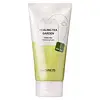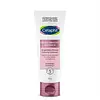The Saem Healing Tea Garden Green Tea Cleansing Foam Versus Cetaphil Healthy Radiance Brightness Reveal Creamy Cleanser
What's inside
What's inside
 Key Ingredients
Key Ingredients

 Benefits
Benefits

 Concerns
Concerns

 Ingredients Side-by-side
Ingredients Side-by-side

Water
Skin ConditioningGlycerin
HumectantPalmitic Acid
EmollientLauric Acid
CleansingStearic Acid
CleansingPotassium Hydroxide
BufferingPEG-32
HumectantMyristic Acid
CleansingCocamidopropyl Betaine
CleansingGlyceryl Stearate
EmollientPEG-100 Stearate
Butylene Glycol
HumectantSorbitol
HumectantSodium Chloride
MaskingPhenoxyethanol
PreservativeParfum
MaskingChlorphenesin
AntimicrobialOlive Oil PEG-8 Esters
EmollientEthylhexylglycerin
Skin ConditioningCaprylyl Glycol
EmollientArachidic Acid
CleansingDisodium EDTA
Polyquaternium-7
Camellia Sinensis Leaf Extract
AntimicrobialSalvia Officinalis Leaf Extract
CleansingSodium Benzoate
MaskingOlea Europaea Fruit
AbrasiveMalt Extract
Skin ProtectingAloe Barbadensis Leaf Extract
EmollientDioscorea Villosa Root Extract
Skin ConditioningSea Water
Humectant1,2-Hexanediol
Skin ConditioningAlanine
MaskingGlutamic Acid
HumectantGlycine
BufferingSerine
MaskingThreonine
PCA
HumectantWater, Glycerin, Palmitic Acid, Lauric Acid, Stearic Acid, Potassium Hydroxide, PEG-32, Myristic Acid, Cocamidopropyl Betaine, Glyceryl Stearate, PEG-100 Stearate, Butylene Glycol, Sorbitol, Sodium Chloride, Phenoxyethanol, Parfum, Chlorphenesin, Olive Oil PEG-8 Esters, Ethylhexylglycerin, Caprylyl Glycol, Arachidic Acid, Disodium EDTA, Polyquaternium-7, Camellia Sinensis Leaf Extract, Salvia Officinalis Leaf Extract, Sodium Benzoate, Olea Europaea Fruit, Malt Extract, Aloe Barbadensis Leaf Extract, Dioscorea Villosa Root Extract, Sea Water, 1,2-Hexanediol, Alanine, Glutamic Acid, Glycine, Serine, Threonine, PCA
Glycerin
HumectantWater
Skin ConditioningStearic Acid
CleansingMyristic Acid
CleansingPotassium Hydroxide
BufferingLauric Acid
CleansingPalmitic Acid
EmollientCocamidopropyl Betaine
CleansingHydrogenated Polyisobutene
EmollientGlyceryl Stearate
EmollientAnhydroxylitol
HumectantArachidic Acid
CleansingButylene Glycol
HumectantCapric Acid
CleansingCaprylyl Glycol
EmollientEthylhexylglycerin
Skin ConditioningHydrogenated Polydecene
EmollientNiacinamide
SmoothingOleic Acid
EmollientPancratium Maritimum Extract
BleachingPolyquaternium-7
Potassium Benzoate
PreservativeSodium Benzoate
MaskingSodium Chloride
MaskingSorbitol
HumectantTrisodium Ethylenediamine Disuccinate
Xylitol
HumectantXylitylglucoside
HumectantGlycerin, Water, Stearic Acid, Myristic Acid, Potassium Hydroxide, Lauric Acid, Palmitic Acid, Cocamidopropyl Betaine, Hydrogenated Polyisobutene, Glyceryl Stearate, Anhydroxylitol, Arachidic Acid, Butylene Glycol, Capric Acid, Caprylyl Glycol, Ethylhexylglycerin, Hydrogenated Polydecene, Niacinamide, Oleic Acid, Pancratium Maritimum Extract, Polyquaternium-7, Potassium Benzoate, Sodium Benzoate, Sodium Chloride, Sorbitol, Trisodium Ethylenediamine Disuccinate, Xylitol, Xylitylglucoside
 Reviews
Reviews

Ingredients Explained
These ingredients are found in both products.
Ingredients higher up in an ingredient list are typically present in a larger amount.
Arachidic Acid is a fatty acid naturally found in peanut oil and cocoa butter. Like other fatty acids, arachidic acid moisturizes the skin.
Synthetically created arachidic acid comes from linoleic acid.
This ingredient may not be safe for Malassezia Folliculitis, or fungal acne.
Learn more about Arachidic AcidButylene Glycol (or BG) is used within cosmetic products for a few different reasons:
Overall, Butylene Glycol is a safe and well-rounded ingredient that works well with other ingredients.
Though this ingredient works well with most skin types, some people with sensitive skin may experience a reaction such as allergic rashes, closed comedones, or itchiness.
Learn more about Butylene GlycolCaprylyl Glycol is a humectant and emollient, meaning it attracts and preserves moisture.
It is a common ingredient in many products, especially those designed to hydrate skin. The primary benefits are retaining moisture, skin softening, and promoting a healthy skin barrier.
Though Caprylyl Glycol is an alcohol derived from fatty acids, it is not the kind that can dry out skin.
This ingredient is also used as a preservative to extend the life of products. It has slight antimicrobial properties.
Learn more about Caprylyl GlycolCocamidopropyl Betaine is a fatty acid created by mixing similar compounds in coconut oil and dimethylaminopropylamine, a compound with two amino groups.
This ingredient is a surfactant and cleanser. It helps gather the dirt, pollutants, and other impurities in your skin to be washed away. It also helps thicken a product and make the texture more creamy.
Being created from coconut oil means Cocamidopropyl Betaine is hydrating for the skin.
While Cocamidopropyl Betaine was believed to be an allergen, a study from 2012 disproved this. It found two compounds in unpure Cocamidopropyl Betaine to be the irritants: aminoamide and 3-dimethylaminopropylamine. High-grade and pure Cocamidopropyl Betaine did not induce allergic reactions during this study.
Learn more about Cocamidopropyl BetaineEthylhexylglycerin (we can't pronounce this either) is commonly used as a preservative and skin softener. It is derived from glyceryl.
You might see Ethylhexylglycerin often paired with other preservatives such as phenoxyethanol. Ethylhexylglycerin has been found to increase the effectiveness of these other preservatives.
Glycerin is already naturally found in your skin. It helps moisturize and protect your skin.
A study from 2016 found glycerin to be more effective as a humectant than AHAs and hyaluronic acid.
As a humectant, it helps the skin stay hydrated by pulling moisture to your skin. The low molecular weight of glycerin allows it to pull moisture into the deeper layers of your skin.
Hydrated skin improves your skin barrier; Your skin barrier helps protect against irritants and bacteria.
Glycerin has also been found to have antimicrobial and antiviral properties. Due to these properties, glycerin is often used in wound and burn treatments.
In cosmetics, glycerin is usually derived from plants such as soybean or palm. However, it can also be sourced from animals, such as tallow or animal fat.
This ingredient is organic, colorless, odorless, and non-toxic.
Glycerin is the name for this ingredient in American English. British English uses Glycerol/Glycerine.
Learn more about GlycerinGlyceryl Stearate is a mix of glycerin and stearic acid.
It is used to stabilize the mixing of water and oil ingredients. By preventing these ingredients from separating, it can help elongate shelf life. It can also help thicken the product's texture.
As an emollient, it helps soften skin and supports barrier-replenishing ingredients.
In cosmetics, Glyceryl Stearate is often made from vegetable oils or synthetically produced.
This ingredient may not be fungal-acne safe
Fun fact: The human body also creates Glyceryl Stearate naturally.
Learn more about Glyceryl StearateLauric Acid is a fatty acid or lipid. About half of fatty acids in coconut oil is lauric acid.
This ingredient helps hydrate and sooth skin. As a humectant, it helps trap moisture. It also aids in cleaning and enhancing the texture of products.
Lauric acid may not be Malassezia folliculitis, or fungal acne, safe.
Learn more about Lauric AcidMyristic Acid is a saturated fatty acid. It is naturally found in milk fat. Other sources include palm oil, coconut oil, and butter fat.
Myristic Acid is an emulsifer and cleanser. As an emulsifer, it stabilizes a product by preventing ingredients from separating. Myristic Acid helps clean your skin by acting as a surfactant. It tends to gather oil and dirt on your skin to be easily rinsed away.
One study from 2021 found Myristic Acid to have anti-inflammatory properties.
Learn more about Myristic AcidPalmitic Acid is a fatty acid naturally found in our skin and in many plant and animal sources. In cosmetics, it is usually derived from palm oil. It serves many purposes in skincare, acting as a cleanser, emollient, and emulsifier.
As an emollient, palmitic acid helps soften and smooth the skin by preventing water loss. In cleansers, it helps remove oil and dirt while creating foam.
Its emulsifying properties help stabilize products by keeping water and oil-based ingredients from separating.
This may not be suitable for fungal acne-prone skin, as fatty acids like this can sometimes trigger breakouts in sensitive individuals.
Learn more about Palmitic AcidPolyquaternium-7 is a light to clear colored liquid. It is commonly found in haircare products for its film-forming and anti-static properties.
According to a manufacturer, it is a non-paraben and specially developed for negatively charged surfactant systems. This makes it a great hairstyle holder and helps to improve wet hair detangling without adding buildup.
Potassium hydroxide is commonly known as caustic potash. It is used to fix the pH of a product or as a cleaning agent in soap. In cleansers, it is used for the saponification of oils.
Sapnification is the process of creating fatty acid metal salts from triglycerides and a strong base. During this process, Potassium Hydroxide is used up and is not present in the final product.
Using high concentrations of Potassium Hydroxide have shown to irritate the skin.
Learn more about Potassium HydroxideSodium Benzoate is a preservative. It's used in both cosmetic and food products to inhibit the growth of mold and bacteria. It is typically produced synthetically.
Both the US FDA and EU Health Committee have approved the use of sodium benzoate. In the US, levels of 0.1% (of the total product) are allowed.
Sodium benzoate works as a preservative by inhibiting the growth of bacteria inside of cells. It prevents the cell from fermenting a type of sugar using an enzyme called phosphofructokinase.
It is the salt of benzoic acid. Foods containing sodium benzoate include soda, salad dressings, condiments, fruit juices, wines, and snack foods.
Studies for using ascorbic acid and sodium benzoate in cosmetics are lacking, especially in skincare routines with multiple steps.
We always recommend speaking with a professional, such as a dermatologist, if you have any concerns.
Learn more about Sodium BenzoateChances are, you eat sodium chloride every day. Sodium Chloride is also known as table salt.
This ingredient has many purposes in skincare: thickener, emulsifier, and exfoliator.
You'll most likely find this ingredient in cleansers where it is used to create a gel-like texture. As an emulsifier, it also prevents ingredients from separating.
There is much debate on whether this ingredient is comedogenic. The short answer - comedogenic ratings don't tell the whole story. Learn more about comegodenic ratings here.
The concensus about this ingredient causing acne seems to be divided. Research is needed to understand if this ingredient does cause acne.
Scrubs may use salt as the primary exfoliating ingredient.
Learn more about Sodium ChlorideSorbitol is a sugar alcohol. It is a hydrating and moisturizing agent created from the reduction process of glucose.
Most sorbitol is usually made from potato starch. It is also found in fruits such as apples and pears.
As a humectant, Sorbitol helps draw water to the skin. This helps keep the skin hydrated. Sorbitol also helps create a thicker texture in products. You might find sorbitol in your toothpaste and other gels.
It is a non-irritating ingredient that is great for those with dry skin.
Sorbitol is a prebiotic. It helps promote the growth of healthy bacteria on your skin. The bacteria on your skin form a microbiome. This microbiome helps protect your skin from infection and harmful bacteria.
Learn more about SorbitolStearic Acid is a fatty acid. It is an emollient, emulsifier, and texture enhancer.
As an emollient, stearic acid helps soften skin. It aids the skin's protective barrier by preventing water loss. It also provides a gentle cleansing effect without stripping away natural oils.
Stearic acid may also be used to enhance the texture of products. It can add volume and stabilize ingredients such as water and oil. This can help water and oil ingredients from separating.
Sources of stearic acid include animal or vegetable fats/oils such as coconut or shea. It can be naturally found in butter, cocoa butter, shea butter, vegetable fats, and animal tallow.
This ingredient may not be Malassezia folliculitis, or fungal-acne safe.
Learn more about Stearic AcidWater. It's the most common cosmetic ingredient of all. You'll usually see it at the top of ingredient lists, meaning that it makes up the largest part of the product.
So why is it so popular? Water most often acts as a solvent - this means that it helps dissolve other ingredients into the formulation.
You'll also recognize water as that liquid we all need to stay alive. If you see this, drink a glass of water. Stay hydrated!
Learn more about Water